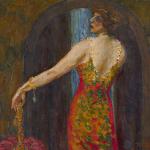Initially, flower beds were created not for aesthetic pleasure, but for medicine. Flower beds with medicinal plants and vegetables were grown at pharmacies and hospitals. And only in the 50s of the 20th century, carpet flower beds became fashionable, which required great effort to maintain their beauty.
Today, beautiful flower beds are made not only from annual plants, but also from perennials. How to grow such a flowerbed with your own hands so that it delights with its beauty for many years?

Peculiarities
A flower bed of perennials is often called a flower bed of continuous flowering, because from early spring until the snow it pleases with its variety of colors. And professional gardeners have a flower bed that blooms even in winter. And this is a clear advantage compared to annual flowering plants.

There are other positive characteristics and features:
- The main thing is durability. In a few years, each plant will grow in such a way that old bushes can be removed completely painlessly and a new shoot will grow in their place next year.
- Easy to care for: before planting, the soil is well fertilized and loosening agents (expanded clay, sand) are added; after planting, the plants are watered in a timely manner and weeds are removed.
- Financial costs are about 1 thousand rubles per flowerbed for several years in advance. While seeds or seedlings of annual plants have to be purchased annually.
- Perennials are considered gentle - they do not deplete the soil and do not require regular feeding.
- Such plants are unpretentious - some of them will grow in the sun, others will be suitable for partial shade, the third will be suitable for shade, and the fourth will grow quietly in any amount of sun.
- To create such a flower bed, there is no need to invite a landscape designer every year.




Even if the flower garden was originally created with its help, then next year the flower bed only needs to be slightly updated. And you can do this yourself.
How to do it?
To create a flowerbed that will delight you for several years, you need to think about the idea of a flower garden before the start of the season. To bring it to life, do not hesitate to seek help from experts or neighbors. The next step in implementing your idea is to create a plan.
It may consist of several points:
- Come up with a name in accordance with the idea.
- Choose a place for a flower garden.
- Think about its shape.
- Present a figurative layout.
- Create a plant planting diagram (it is better if it is colored, voluminous, very detailed, drawn from several angles, indicating the time of flowering of plants), taking into account light and shadow.


- Select plants in such a way that the flower bed blooms continuously and includes low-growing plants and flowers with long stems.
- Pay attention to the soil: add fertilizer and loosening agents.
- Frame the flower garden: live or artificial.
- Carry out pre-planting work: loosening and watering.
- Plant flowers, not forgetting that they will grow over time (which means that now they need to be planted at a considerable distance from each other).
- Regularly photograph your flower garden to avoid mistakes when designing other flower beds, as well as to preserve this beauty in your memory.




When selecting plants, you need to remember that for one square meter they use:
- about 10 ground cover flowers;
- no more than 7 short ones;
- plants of medium height – 5;
- plants on a high stem - no more than 7.


Kinds
Based on the density of plantings, there are several types of flower beds:
- Solitaires– a solitary plant (flower or bush) with large flowers and large leaves; they should be clearly visible; More often these are roses, mallow, amorpha.
- Discounts– narrow floral stripes stretching along the fence, house walls, paths; To add beauty, 2-3 types of plants of different heights and colors are planted.
- Curbs– this is a kind of flower edging of a flower bed; borders are always low-growing and monochromatic, and the color is chosen to be contrasting with the flowerbed; In addition, you can choose plants with a strong aroma that will smell fragrant on summer evenings in the garden.
- Parterres– flower beds that need space, as they include several elements: lawn, ridge, border.




- Mixborders popular with non-professional gardeners, as they plant plants of different flowering periods and colors; This flowerbed blooms from early spring until frost.
- Arrays That’s why they are called that because they occupy a large area; This includes plants that do not require close attention to themselves, and this attracts amateur gardeners.
- Groups– flower beds of any, usually smooth shape; their main difference is the bright spots in the middle of the lawn or area.
- Arabesque decorated using colored stones and pebbles, the location is horizontal and inclined.
- Vases, for example, gabion is a mesh used as a metal frame-basket for stones.
- Rockery or rock garden– imitation of mountainous terrain.

Materials
No matter how wonderful the flowers themselves are, they need to be beautifully decorated. After all, flower beds can be very diverse. And if professionals use special devices and structures, then amateurs use improvised materials for this: pieces of brick, tires, old basins and watering cans, old shoes, boxes, dishes, cobblestones, pieces of metal, canvas.
Roofing felt, polyethylene, and cement mortar may also be useful. The main thing is soil, sand, expanded clay.

Place
Before choosing a location for a flower garden, you need to consider the following points:
- will it interfere with the passage;
- will it be clearly visible;
- will he have enough sunlight;
- what form is most suitable for the selected plants;
- what function should the flower garden perform;
- When will peak flowering occur?




Based on this, and also depending on the available space, choose the following places for flower beds:
- along the path or at the end of it;
- along the fence;
- in front of the house against the background of buildings;
- on the border of two functional zones, for example, a recreation area and a vegetable garden;
- on an artificial or natural slope;
- on stairs;
- on lawns;
- In the case of vertical or raised flower beds, the locations can be very different.

Dimensions
The size of the flower arrangement should be strictly proportional to the area of the plot: for a small plot - a small flower bed, for a large plot - a large flower bed or several flower beds.
Flowerbeds can be of completely different sizes: from 0.75 m (tapeworms) to 20 m in diameter for arrays. But usually round flower beds have a diameter of 4-6 m. Works can be several hundred meters long. According to technology, the soil is always made convex, the slope is 5-10 degrees. This is done for water drainage and a better view of the flowers.


The highest plant height is considered to be 50-80 cm. But this is only if shrubs are not used. When using, for example, evergreen thuja as the main plant of a flower garden, the height will be much greater. Border flowers rise 8-10 cm above the lawn.


Colors
At the idea stage, you need to think carefully about the color scheme that you would like to see in the flowerbed. The color combination can be very diverse.
The principle of creation is as follows:
- Monochrome flower bed - one shade, but different plant heights; A white flowerbed is especially chic - it looks very gentle both vertically and solitaire.
- Contrasting allows for a color explosion.
- From plants of similar shades - a smooth transition, for example, from red to yellow or from lilac to pink.
- Neutral colors are calming to the eye, such as green rose bushes with white flowers.




Flower beds are planted for visual relaxation or emotional outburst.
Psychologists, together with florists, offer tips on placing and combining flowers in a flower bed:
- for calmness you need to choose either warm or cool colors; for an emotional explosion - contrasting colors;
- Smooth plant leaves reflect color, matte leaves absorb color;
- to enhance the visual appearance of the flower beds, minimize the number of flowers and their contrast;
- to visually enlarge a flower garden located along a fence or building, tall blue flowers are planted in the background, and low-growing yellow ones in the foreground;


- bright colors in the foreground, which means those in the background are calm;
- several flower beds combined into one flower garden should be formed as follows: the background is calm, bright colors - in small groups;
- on a large area it is allowed to create one flower bed with bright plants;
- if there is a bright alpha plant in the flowerbed, then the rest of the flowers should be its pale shadow;
- before planting, it is better to draw in color the area that this or that color will occupy: a small red spot among blue flowers is appropriate, a large one is annoying;
- A rural resident prefers bright colors, an urban resident prefers pastel shades: you need to take into account the location of the flower garden, not only its urbanization, but also the climatic zone.


Form
Since perennials will grow in the same place for several years, it is necessary to carefully consider the shape of the flower bed. At the same time, it must be in harmony with nearby structures: a house, a gazebo, a path, a fence.
Modern design is increasingly moving away from the usual forms, nevertheless, everything is based on them:
- a round or oval flowerbed can accommodate a tree or shrub in the center, and herbaceous plants around the circumference; flowers are planted in such a way as to create continuous flowering from the edge of the circle to the center;
- a rectangular flowerbed is decorated with a pattern and ornament from the plants themselves;
- a square or diamond is suitable for bright portrait paintings, drawings of animals, etc.;
- the use of triangular flower beds requires certain skills: individual triangles look harmonious in an area of clear geometry, in other cases a triangular flower bed should become part of a polygonal flower garden;
- long flower beds - edgings may or may not be symmetrical, but they are located along the paths or parallel to them.




Flowerbed design
There are many design options for designing flower beds. You can always come up with your own version. But first, we suggest you get acquainted with the existing flowerbed designs.
So, according to the design idea, the flowerbed can be:
- Regular- This is a flower garden that represents clear geometric shapes or ornaments. This flowerbed is very similar to a carpet, but it differs in its geometric pattern.

When creating such a flower garden, the following conditions must be taken into account:
- plants should not be in the shade at all;
- they need to be planted not singly, but rather densely;
- For such a flower bed, it is better to use a group planting method rather than a row one;
- flowers must be the same height, time and period of flowering;
- after planting, there should be a few plants left in case of replacing wilted flowers;
- such flower beds consist of perennials and annuals; if desired, they can be decorated with perennial roses, peonies, hosta, as well as bulbous tulips, crocuses, lilies, daffodils, gladioli;
- A regular flower bed is not the easiest to care for; it is better for beginners to use other types of flower beds.


- Irregular- a flower garden that is easier to create, consisting of annual and perennial plants, as well as ornamental shrubs, conifers and vines. Perennial flowers or shrubs can be the centerpiece. And every year you can plant annuals around them. With proper organization, you can create a flower bed of continuous flowering, when the plants bloom alternately.
Perennial peonies, delphinium, phlox, rose bushes, and drought-resistant allium are suitable for this. They can be supplemented with snapdragons, asters, and balsams. A beautiful frame will be made from marigolds.

- Carpet is the most labor intensive. In addition to significant material costs, it will require artistic taste and knowledge of floristry. Flowers for such a flowerbed are selected with good bushiness, same-level height, but different colors. A carpet flower bed is a drawing, and not necessarily a traditional carpet: it can be a cartoon character, an animal drawing, or a portrait. This is how it differs from a regular flower bed.
- Elevated most common in cities. But amateur gardeners also create such flower beds from scrap materials and even old carts and cars. The soil in such structures warms up faster, but it also needs to be watered more often. But alpines and dwarf trees look good here.


- Vertical- this is a flowerbed or several mini-flowerbeds located at a height from the ground. When creating such a flower bed, a water drain must be provided.
- Multidimensional- a more complex version of a vertical flower bed. This is a three-dimensional flower garden in the form of a specific animated image or piece of furniture. But it can also be an entire landscape composition with mountains, hills and ponds. The main thing is to think about watering such a “curvy” horse or gnome.


- Ring a flower bed is created to frame a tree, a monument, or a raised flower bed. The rule for planting plants in such a flower garden is from the high center to the low edge. In this case, you can create several multi-colored rings. If you plant an unpretentious purslane here, it will withstand hot sun, partial shade, and light frost.
- Ostrovnaya the composition may consist of a large stone and several perennial bushes. A distinctive feature is a small flowerbed in a large flowerless space. The main care is to mow the grass around the flowerbed in a timely manner so that it does not fill the flower garden.


- Flowerbed panels They require quite a large space and therefore are not suitable for every garden plot. In addition, this is a complex composition that requires floristry skills. But if you manage to create such a panel from perennial (together with annual) flowers, then it will be a real decoration for your personal plot.

- Modular a flowerbed is constructed instead of several paving slabs. This option can be provided before installing the coating. The flower garden is extremely beautiful and original. On a small plot of land, a “checkered” module will expand the space and adjust its shape. If it is impossible to remove the tiles from the paving, a false module is made: several containers with soil and plants are installed in the right places and framed with stone or vibro-cast tiles.

- Monoclumba– the simplest design solution, there can be two options:
- plants are different in appearance, but the same in color;
- plants of the same species, but different colors and flowering times (rosary is a typical monoflower).


Required Tools
Depending on the type of flower bed, you may need different tools to make it. The main ones will be:
- hammer;
- axe;
- hacksaw;
- Master OK;
- construction scissors;
- plastic borders;
- level.


To create and care for a flowerbed, you should always have on hand:
- shovel;
- spatula (scoop) for planting plants;
- rake;
- rakes for removing debris between perennials;
- hoe or weeder;
- watering can;
- cultivator for preparing and loosening the soil;
- gloves.

For beginning flower growers, professional florists and experienced summer residents have prepared some tips:
- You shouldn’t start with complex design solutions, but you shouldn’t be afraid to invent your own shapes for flower beds;
- to begin with, it is better to place multi-level perennials in long rows;
- the correct selection of plants will ensure wave flowering throughout the season;
- in addition to flowers, you must include plants with beautiful multi-colored foliage;
- low and medium-sized plants need to be planted at least two, giving them the opportunity to grow;
- if there are concerns about the wrong selection of plants, it is better to make 2-3 flower beds with different color options;
- If you don’t like the result, you can remove the plant and replant another one next year.

Flower beds and flower beds on a personal plot are intended primarily for aesthetic pleasure. But besides this, they perform another important role: acting as an extension of the house, flower arrangements allow you to visually combine the appearance of the building with the vegetation of the garden into a single whole. Knowing the secrets of landscape designers on how to design a flower bed will allow any gardener to create flower arrangements in their suburban area that, in addition to aesthetic appeal, will create an atmosphere of harmony and comfort.
General rules for creating a beautiful flower bed
When thinking about decorating a flowerbed with your own hands, it is advisable to be guided by the basic rules of landscape design.
Rule #1 – integrity of the picture
A garden is a picture made up of a collection of landscape compositions. The gardener's task is to bring each of the elements of the landscape to perfection. Pointless planting of plants around the site will not give the desired result. Therefore, without being able to landscape the entire territory, to begin with it is worth improving only a small part of it, but making it complete.
Beautiful harmonious flower beds are created by combining mixed plantings, which contain both annuals and perennials, both flowering and decorative foliage plants
Rule #2 – placement of plants by height
The multi-tiered principle involves placing ground cover and low-growing plants in the foreground, which act as a frame for beautifully blooming medium-sized flowers.
Medium-sized perennials, acting as soloists in the flower garden, will become the center of attention. Tapeworms look most impressive against the background of tall plants with decorative foliage or flowers in contrasting shades. Combinations of tall perennials and their medium-sized companions, harmonizing in color and shape, are also successful.

Quite unpretentious and at the same time possessing an expressive leaf texture and color variety, capable of quickly filling empty spaces, they are ideal for decorating flower beds in the countryside
Rule #3 – flower garden architecture
Depending on the landscape features of the site and its size, the design of flower beds can be made either in the form of flat compositions or slightly raised ones and framed with decorative tiles or stones.

The shapes of flower beds can be very diverse, starting with free ones without clearly defined boundaries and ending with original curly and wavy ones.

In order to give an unusual shape to a flower garden, you can use any household items: barrels and baskets, old cars, boats and even beds
In order to design a flowerbed in front of the house, which will become an expressive decoration of the garden and will delight you with its blooming splendor throughout the season, you must first draw its plan on paper. This creative work will allow you not only to organize thoughts in your head, but also to visualize images of flower arrangements, creating the most successful combinations.

For work, it is advisable to use colored pencils: the bright colors of the spots of schematic images of group and spot solitary plantings in a flower garden will allow you to correctly distribute plants with different colors and flowering periods

According to the plan, terry mallows (1) will be placed in the background next to the decorative sunflower Mishka (2), in front of it will be poppy bushes (3) and St. John's wort (4). The lobelia ribbon (5) will add dynamism to the composition. Purple-blue accents will be provided by catnip (6), bluebell (7) and kalanchoe (8). The foreground will be occupied by gravilate (9), sedum (10) and aquilegia (11)
The diagram drawn up is only a kind of rough sketch: the final decision on the optimal placement of flowers will come in the process of planting plants.
Schemes for the original design of flower beds
By painstakingly selecting and combining beautifully flowering plants, you can create many variations of flower beds in which beauty will reign from the first days of spring until frost. Ready-made flower bed designs will make the process of creating a flower bed much easier.
Option #1 – central flower bed
The layout of the central flower bed is one of the simplest.

The shape of the flower garden has the form of concentric circles: the center is filled with dark-leaved cannas (1), which act as soloists of the composition, then green-leaved cannas (2), decorative leafy gnafalium (3) and snapdragons (4) are planted in a circle.
Option #2 – “Vienna Flower”
One of the options for how to beautifully decorate a round flower bed is to create a composition in the shape of a flower. A flowerbed decorated in the shape of a six-leaf flower looks especially elegant and festive, and therefore it is advisable to allocate a central place in the garden for its arrangement.

The center of the composition is the beautiful white gillyflower (1), the frame is a border planting of alpine forget-me-nots (2) against the background of lawn grass (3). The outer contour of the ornament is created by violas (4), primroses (5), zinnias (6), framed by decorative variegated foliage beauties alternathera (7) and achyranthes (8)
Option #3 – “Bizarre Pattern”
A round flowerbed, decorated with many repeating wave-like elements, which are decorated with a motley company of sun-loving perennials, allows you to create a real parade of flowers on a sunny stage.

In the center of the flowerbed there is a squat chamerops (1) with a chic crown of fan leaves, in its shade there is a dahlia zinnia (2), with a contrasting background of coleus (3). Solitaire plantings of dracaena (4) in combination with group plantings of pelargonium (5) and begonia (6) create a fancy pattern of curls that looks impressive against the background of lawn grass (7)
Option #4 – “Piece of Cake” in a corner of the garden
A flower bed of this shape can find a place in any corner of the garden.

A plant composition in burgundy-red tones, bordered by a silver edge, occupying only a couple of meters of area, will become an elegant decoration for the garden

The corner of the flowerbed is filled with three daylily bushes with dark burgundy flowers (1); the silvery leaves of wormwood (2) act as a contrasting background for them. The center of the composition is bright red heuchera bushes (3), the corner elements are Macedonian bark bushes (4), and the silver edge is chistets (5)
The proposed diagrams are only a guideline: in the absence of the desire or opportunity to purchase this or that plant, you can always replace it with a flower you like more, presented in the same color scheme and having similar flowering periods.
Decorating a flower garden in front of your house with your own hands is not as simple a task as it seems at first glance. To decorate the front area with a magnificent flower bed, you need to take into account all the little things and study the rules for arranging a flower garden. One mistake can ruin all your efforts.
- 1 If during the day direct rays fall on the place where the flower bed will be located for at least 7 hours, you can safely plant light-loving plants.
- 2 When direct sunlight illuminates the area only for 2-3 hours in the morning and the same amount in the evening, and the rest of the time there is shadow from the trees, the lighting of the flower bed in front of the house is considered diffused.
- 3 Plants that prefer partial shade should be planted if direct rays do not fall on the flower garden in front of the house, but the lighting of the area is bright enough.
- 1 If nettle, clover and coltsfoot grow on it, then the soil has a neutral or slightly alkaline reaction. This is an ideal soil for planting asters, tulips and carnations.
- 2 Horsetail, moss and sorrel thrive in acidic soils. In their place, lily of the valley and rhododendron grow well.
- 3 You can safely plant roses and gladioli on neutral and slightly acidic soil.
- Tall representatives of the flora for the center of the composition:
- Medium-growing perennials for a modest addition:
- Ground cover plants for edging flower beds and filling gaps:
- paniculate phlox pink or purple in color. The best time to plant is September or mid-March, grows well in well-drained, sandy soil, blooms from mid-July to autumn;
- pink astilbe. Flowering of different varieties lasts, as a rule, from late June to mid-August, the plant is responsive to regular feeding and loosening;
- purple-silver daylily. Plants are planted in spring in organic-rich and well-drained, loose loam with an optimal acidity of 6-6.5 pH;
- Heuchera with silver-gray and lavender leaves. Prefers light soils without stagnant water, blooms from May to July;
- geranium is magnificent. Blooms profusely from mid-summer to late season, forming a lush bush with light purple flowers).
- hollyhock "Pleniflora" with densely double corollas of yellow, salmon-pink and red-purple flowers (“Pleniflora” is not a rose, but a giant mallow that blooms profusely in sunny and moist areas of the garden from mid-summer until the first cold weather);
- ten petal sunflower(a very valuable variety, blooming from mid-August to mid-October, grows well and has healing properties);
- Icelandic poppy(ideal for an ever-blooming bed of perennials due to continuous flowering from May until autumn);
- St. John's wort "Hidcote"(“the odorless” type of St. John’s wort pleases with yellow inflorescences in the flowerbed from June to September);
- lobelia cardinalis(a plant with a beautiful leaf plate and blood-red flowers are decorated from July to October);
- catnip "Nepeta faassenii"(blooms with lavender-like flowers for a long time, starting in May);
- bell "Campanula poscharskyana"(the crystal ringing of these delicate and fragile lilac-blue flowers can be heard from June to September);
- Catananche "Blue Cupid"(inflorescences-baskets of a muted heavenly shade can be observed all summer);
- perennial gravilate(in the composition of a long-flowering flower bed, the herbaceous plant of the “Feuerbal” variety does not solo, but rather complements the flower garden from May to July);
- sedum "Matrona"(a strong bush with beautiful flowers remains decorative until the first snowfall);
- Heuchera "Miracle"(a spectacular bush with unusually colored foliage decorated with pink flowers from June to mid-summer).
- changeable highlander with bluish-green thin leaves, this large perennial bush blooms in a “white cloud” at the end of June and remains in bloom until the end of summer;
- Monarda hybrid creates a romantic mood at the dacha when, during flowering, its pink flowers begin to exude a divine aroma;
- Astrantia "Claret", its small, numerous flowers-umbrellas of a rich red-wine color, blooming in mid-summer, look luxurious against the background of dark purple leaves;
- Bergenia(Saxifrage thickolitis) pleases the eye from May to July with paniculate-thyroid inflorescences on long stalks.;
- Phlox "Dragon" with its smoky silver-violet petals, it looks especially attractive in the composition of a sunny flower bed;
- Heuchera "Obsidian" hybrid with dark purple-violet, almost black leaves blooms in June;
- geranium "Compactum" grows very lushly, adding blood-red tones to the flower garden;
- Sedum telephium or hare cabbage, variety "Matrona" blooms in mid-summer with pale pink inflorescences;
- bell "Loddon Anna" with soft purple wide-pyramidal inflorescences fill the garden with a delicate aroma from July to September.
- 10 pieces of ground cover plants;
- 7 pieces of undersized ones;
- 5 pieces medium-sized;
- and 1-3 tall plants.
Show all
Choosing a suitable location
In local areas there is not always a wide choice of places for flowers. Paths, outbuildings, a playground and parking space take up space. However, from the remaining plots it is necessary to choose the most suitable one.
The best place for a flower garden will be the area located in front of the southern wall of the house. The construction will protect the plants from cold northern winds. The flowerbed should not be in a draft - most plants cannot tolerate it.
It is advisable that the selected area does not receive direct sunlight all day. It is better not to choose a place in a low area, as moisture will accumulate in the soil. Rainwater from the roof of the house should not pour onto the flower garden. In the roots of perennial plants, when there is an excess of water, putrefactive processes develop. In such conditions, root nutrition is disrupted.
Lighting and soil
Before choosing plants for decorating a flower garden, you need to determine the type of light in the selected area.

On unsuitable soil, the flowers will be weak and unattractive, and they may even die. To find out the type of soil, you need to slightly moisten it to the consistency of plasticine. From wet soil you should try to roll a sausage with a diameter of 0.5 cm and roll it into a bagel. If the donut is rolled up, the soil is classified as heavy clay soil. If the donut has fallen apart, it means there is loam in the area. Light sandy and super-sandy soil cannot be rolled into a sausage.
Heavy soil can be made lighter by periodically adding sand or sawdust. Rotted manure or compost will perfectly “weight” the soil.
To determine the acidity of the soil, you need to look at the wild flora of the selected area.

Most plants prefer neutral soils. You can make the soil neutral with your own hands by acidifying or alkalizing it artificially. Wood ash, chalk or lime should be added to acidic soil; pine needles or peat should be added to alkaline soil.
You can prepare the soil for a flower garden in a more radical way by completely replacing the top layer.
Determining the shape and size of the flower bed
At this stage, you need to determine the shape of the flowerbed and its dimensions. One large flower bed looks more advantageous compared to several small flower beds. But small areas are easier to care for. Flowers can be planted throughout the selected area, following its natural contours, or you can choose the appropriate shape of the flower bed. The design of the flower bed depends on the illumination of the area.
Good lighting
In such conditions, you can arrange a traditional flower bed. It changes its “composition” 2-3 times a year. The first to bloom are tulips, daffodils and crocuses. After them, peonies and cornflowers bloom. Closer to autumn, the flower garden is covered with magnificent asters, dahlias and gladioli.
Irregular flower beds look more natural, in which flowering plants change constantly; they are placed in groups in the flower garden.
If there is a shortage of space, vertical flower beds are an excellent option. They are created from pots with flowers mounted on a special frame made with your own hands from scrap materials.

Scattered light
For less bright lighting, a chameleon flower bed is suitable. It will surprise you with a sharp change in flowering plants of the most unexpected colors. This is a variation of the traditional flower bed, from which the chameleon differs in its faster changes. Violets, irises, delphiniums, and bush asters continuously replace each other from spring to autumn.
Carpet flower beds are decorated in the form of an ornament. Low-growing flowers coexist with decorative foliage plants, covering the flower garden with a bright and fragrant carpet with a pattern.
A ring flower bed can surround a sculpture, tree, gazebo, lantern or fountain. Tall flowers are planted on the inner ring, and shorter flowers are planted on the outer ring. A large ring flowerbed can contain several tiers of flowers: from the highest to the lowest, representing a truncated cone.

Penumbra
In poor lighting conditions, it is better to arrange a flower garden of plants blooming at the same time, planted in groups at a distance from each other. A large monoflower bed of one type of plant looks good.
Landscaping of the greenhouse
You can draw a plan of the site and see how the chosen shape of the flowerbed will look on it, how the colors of the plants will combine and how they will look from every corner of the territory.
When choosing flowers, you should give preference to species that bloom for a long time or repeatedly.

If flowers quickly lose their attractive appearance, they should be placed in small groups among varieties of tall flowers that bloom later. In this case, fading plants will not spoil the overall appearance.
Tall plants should not obscure shorter species. Flowers need to be planted in a cascade. Closer to the edge of the flower garden, the plants should not only be lower, but also smaller.
A bright, large, luxurious flower - the pride of the owner - can be planted separately, at some distance from other plants. So that it can be seen from everywhere. Instead, you can place the tallest flower in the center: a large gladiolus or rose bush.
You should also thoroughly study the properties and characteristics of the selected plants before determining their place in the flowerbed. Some species do not get along well together.
There is no need to try to plant the front area with rare and difficult to care for flowers. Between perennial plants it is recommended to place unpretentious annual flowers that reproduce by self-seeding (marigolds, calendula, petunias). They bloom luxuriantly and fill the entire space, leaving no bald spots.
The effect of less capricious plants will be no less if the color scheme is chosen correctly.
Color palette
It is necessary to select plants not only depending on the size and time of flowering, but also on color. The color scheme of simultaneously flowering plants should look harmonious, as a single whole, like a painting.
When choosing a color, it is recommended to use a color wheel, dividing shades into warm, cool and neutral. The passive half of the circle contains only cold tones: purple, blue, green. Flowers with cool colors of petals and leaves decorate the background of the flower bed or its edges. Blue color is considered to be the coldest, iciest.

The active half includes warm colors: red, yellow, beige, cream. The “hottest” color is orange. Active tones decorate the central elements of the picture.
Black and white colors are considered neutral. They are used to smooth out shades that do not match each other, placing them between them.
Designers recognize the pairs red-green and blue-orange as the most harmonious combinations. The combination of purple and yellow shades also looks beautiful.

One type of flower can be planted in different colors. For example, the yellow and purple violet called Vitrocca. Both flowers will benefit if the combination is complemented with a plant with orange petals.
It is not necessary to adhere to existing rules on your site. Sometimes new combinations look so exotic and bright that they attract attention to a much greater extent than familiar combinations. You should not be afraid to experiment and look for new design solutions.
Flowerbed design
How to arrange a flower bed?
Any item will be suitable as a border for a flower bed. You can use leftover building material or a car tire. By cutting tires, you can create different shapes of flower beds. One whole tire is placed in the middle of the flower bed and flowers are planted inside. The halves of the tires are located around it, forming petals around the central circle-middle.
The border can be planted with green dwarf plants or pruned bushes. From a large bush you can build a basket with a handle with your own hands. The middle of the plant is removed along with the root. A handle is formed from the crown in the form of an arc hanging over the flowerbed. Small bright flowers are planted inside. Red-pink cornflowers, white zinnia and poppies, blooming alternately, will look great in a “basket.” This flowerbed design will cause surprise and admiration among guests and passers-by.
To plant a flowerbed of perennials at your dacha, you do not need to obtain a higher education or be a certified landscape design specialist.
What to plant - onions or perennial flowers?
Not everything in the garden should be for the belly, you need to leave room for “beauty” - just for the soul. A flowerbed of continuous flowering perennials can easily decorate even the most inconspicuous area, giving it a unique charm. Roses, geraniums, carnations, poppies and asters will grow in the same place season after season without requiring special attention.
A question that every novice gardener must understand is the choice of plants for a perennial flower garden. From practical experience, the first flowerbed should be made small and planted with unpretentious flowers that grow well under the bright sun.
A flowerbed is a bright element of the garden, so there is no point in planting it in the far corner of the site or hiding it under the shade of trees. The optimal solution for creating a perennial flower bed would be a place that is clearly visible from all sides.
Multi-level flower beds (with tall plants in the background and short ones in the foreground) are usually placed near the walls of the house, fence or hedge. Whereas in the center of the site, a constantly blooming flowerbed of perennials can either form all sorts of combinations of plants, or be decorated with only one species.

Perennial flowerbed for beginners
Flower garden puzzle of the most popular flowers - assemble it yourself!
Roses, astilbe, lilies, asters, claricas, peonies, black cohosh, Hassler's cleome, delphinium, decorative onions, phlox, helenium, Zopnik ruselovsky, lupine multifolia, clematis, hosta, hydrangea, rudbeckia, liatris spicata, poppy, meadow bells, ratibida columnar , echinacea, daylily and many others.
Tulips, anemone, irises, fragrant rue, navel tincture, aquilegia, beautiful small petal, mountain cornflower, hybrid catnip, magnificent dicentra, oak sage, gravilat, yarrow ptarmika, heuchera, bergenia, lavender angustifolia, primrose, fern, evening primrose quadrangular, etc.
Chistets Byzantina, acena, small periwinkle, creeping tenacious, Renard's geranium, aubrieta, Carpathian bellflower, grass carnation, lobularia, spring umbilical cord, Waldsteinia, lungwort, small periwinkle, speedwell and others.
It is recommended to plant tall soloists individually, but small flowers are best planted in groups, several at a time. At the same time, in a flowerbed viewed from different angles, taller individuals should be planted closer to the center, and shorter ones should be planted along the edges.
Advice. To prevent bald spots from gaping in the flowerbed and weeds from growing, plant the plants as close to each other as possible, but not too crowded.
Want to achieve continuous flowering? Find out about the characteristics of each flower, write down the flowering time on a piece of paper and create your own combination diagram of a beautiful club of perennials, in which some plants will bloom in early spring, others in mid-summer, and others will bloom until late autumn.
Of course, thinking through the ideal design for a luxurious flower garden is a special task. But, fortunately, there are proven designs for flower beds of perennials.
Perennial flower beds - the best planting schemes
Several options for arranging plants in flower beds - schematic symbols with the names of perennials.
Scheme No. 1 “The most simple”

In this simple and attractive long-flowering composition, such unpretentious perennials were used as:
Scheme No. 2 “Example of a flower bed of perennials blooming in the first year”

Scheme No. 3 “Pink and purple beautiful flower bed”


Material prepared for the website www.site
Creating a flowerbed of perennials: soil preparation and planting
Having decided on the ingredients for the flower bed, it’s time to start preparing the soil for the flower garden. This is the most uncreative and labor-intensive task in creating a perennial flower bed. But, at the same time, it is also the most necessary thing, because properly prepared soil is the foundation of a future flower bed.
You need to prepare the soil after you have drawn a sketch of the future flower garden. You need to choose plants not only according to their flowering time, but also according to their similar requirements for light, moisture and soil - this will greatly facilitate caring for the flowerbed. (For example, in shade and semi-shaded areas in dry areas with fertile and loose soil, the following grow well: heucheras and hillocks, lilies of the valley and mantles, primroses and phlox, irises and geraniums, periwinkles and anemones).
How to make a beautiful flowerbed of perennials?
Start by removing the old sod with a shovel. Remove all weeds with their roots and revive the soil by diluting clayey soil with sand, and light soil with clayey soil or bentonite. Then add compost (this will make the soil more fertile) and loosen the soil as deeply as possible with a fork, mixing clay, sand and compost. Add the necessary fertilizers and start planting seedlings.
Please note that in a flowerbed of any design, approximately the following is planted per 1 sq.m.
Now you know how to arrange a flowerbed of perennials.
Flowerbeds of classical forms are becoming less and less common in landscape design. In landscape gardens these days, island flower beds with plant species that are asymmetrical in height and planting, arranged on lawns and lawns, are more appropriate. Multi-level vertical plantings are no less popular. Raised flower beds planted in flower beds of original shapes, mini-beds in old stumps and cascades of rectangular stands bordered by broken bricks also look interesting.

Tip: If possible, the shape of the flowerbed should be combined with the shape of the nearest building, for example, a gazebo or porch.
Round flowerbed of perennials
If we talk about the simplest method of flower decoration of an area, then this is, of course, a round flower bed of perennials, which is very easy to make with your own hands. It is very important to choose the right size. Since on a large area a small flower garden will look ridiculous, and a too-voluminous flower bed within a limited space will be poorly visible.
Important! When decorating a garden with a flower bed of perennials (for a harmonious combination of all elements), be sure to take into account the surrounding situation.
The place for the flower bed should be cleared of weeds, debris and stones. Break up large lumps of earth, dig up the ground and level it with a rake.
To accurately draw a circle, you need to take a peg, drive it into the center of the future flowerbed and tie a rope to it, at the other end of which there will be a peg. They need to draw the correct circle of the required size.
DIY diagram of a round flower bed of perennials and annuals

 with large white flowers, compactly collected in inflorescences;
with large white flowers, compactly collected in inflorescences;
 , often used to decorate borders;
, often used to decorate borders;
 with characteristically narrow, linearly elongated leaves, which, intertwined, form a continuous bright green carpet;
with characteristically narrow, linearly elongated leaves, which, intertwined, form a continuous bright green carpet;
 4. (Viola) pansies, specifically the variety “V. t. Maxima" - a tricolor violet that blooms all summer;
4. (Viola) pansies, specifically the variety “V. t. Maxima" - a tricolor violet that blooms all summer;
 - an unpretentious plant that blooms in spring with yellow fragrant flowers;
- an unpretentious plant that blooms in spring with yellow fragrant flowers;
Now that the summer season has not yet begun, we mentally rush into the garden with the question, what to do in the garden this year? We think about what went well in the garden and what didn’t work out. Which flowers have taken root and survived the winter - it’s like the return of old friends. And what new flower beds near the house we can make this year.
We arrange flower beds near the house.
It is often thought that in the new season it is enough to complete what was started in previous years and work with what is already there. However, new ideas, new beautiful varieties of flowers, tempt us into new projects.

For example, make a flower bed near a blank wall of the house, so it will obviously look better.

It is better to use unpretentious perennials for the base - phlox of different colors are perfect, and for annuals you can place them in pots on a shelf on the wall of the house. Petunia will feel great there. And our flowerbed will gain additional height and volume.

Are there any other new ideas? I want to show some plants close-up: create more romantic corners in partial shade near the house - delicate bluebells are suitable for this.

And the hosta will decorate shady areas with its presence. Carefully bending around the garden gazebo, it creates a secluded corner of the garden right next to the house.

And as usual, many spontaneous projects appear in the spring. We offer a few photos to give you new ideas. Look how perfectly herbaceous hibiscus and verbena combine in a flower garden.



This fluffy beauty is nothing more than borage. It actually grows like a weed. But look how beautiful she is! In addition, it is used in food as a seasoning, and its dried leaves can be used to make a tonic tea.

Make more flower beds in your garden this year - expand the space in your home so that you want to go outside to beautiful and fragrant flower beds.

How to landscape a summer cottage.
Flowerbeds on the terrace near the house.
In order to extend a pleasant and amazing summer day, you can make a flower garden right on the terrace near the house.

Simple wooden boxes are assembled to serve as both patio railings and containers for flower pots.

Imagine the views that open up when you step outside! The flowers on the terrace merge with the flower beds near the house. And it’s like a magical little world that you created with your own hands.

How to beautifully design a garden.
It always seems that spring moves too quickly to implement all the planned projects. But you can also do small but lovely details to improve your garden throughout the entire season.

Thus, the barbecue area near the fence can be decorated with perennial vines and flowers in containers.

And put the firewood for the barbecue in such a beautiful firewood rack. Both comfortable and beautiful.

The fence area near the house can be used as a mini herb garden.

And where would we be without a garden! Both old and young are ready to work on such a convenient high bed.

When the garden is in order, you can start improving the paths between the rows.

Cozy house in the country.
This house was built in the 50s and is now used as a summer house.

It's nice to relax in a cozy bedroom after a busy day.

Children have their own place in the house.

And my favorite room in the country is the attic.

The plot of 6 acres was completely abandoned until people began to actively go to the dacha in 2004. And the house came to life, we smelled of bread and warmth.

How to make beautiful flower beds near your house with your own hands.
“No new projects in the garden,” that’s what the owners told each other at the beginning of the season. There's plenty of other work to do, and you can't get too worked up about it. And when all the sowing was finished and everyone calmed down a little, a child came from kindergarten and said, “I want my own flowerbed!” — they were told that it was time to start taking care of someone. No sooner said than done.

We mark the flowerbed with a hose.

Remove the layer of turf.

We lay newspapers around the perimeter, which will slightly muffle the growth of weeds, and lay stones.

The plan was that in the future, this flower garden near the house would turn into a small green room.

A couple of years later, when I climbed up the trellises, this flowerbed became one of the best corners of the yard.

Planning a new flower garden never seems difficult, but in reality it always takes more time! It's good to have an ally in your plans. And the more you do in the garden, the more interested you become in new ideas. It's funny when my husband constantly asks if he needs to dig up somewhere else.

is a creative necessity. She gives us so much - color, shape, imagination, perseverance, responsibility and care... the list can be endless!

What are you planning for the new season?



















